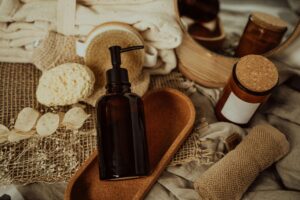In our everyday lives, we’re exposed to numerous chemicals and pollutants from sources like processed foods, household products, personal care items, and environmental factors. This accumulation of chemicals in our bodies is known as our “toxic load.”
Over time, a high toxic load can contribute to health issues like hormone imbalance, fatigue, skin irritation, and even chronic diseases. Understanding toxic load and knowing how to reduce it can help you make healthier choices, lessen the strain on your body, and improve your overall well-being.
In this post, we’ll explore what toxic load is, how it impacts health, and simple, effective strategies to lower your exposure to everyday toxins.
Understanding toxic load
Your body has a natural detoxification system—primarily managed by the liver, kidneys, lungs, and skin—that works to process and eliminate toxins.
But when the level of toxins you’re exposed to exceeds what your body can handle, those toxins begin to accumulate, increasing your toxic load. This accumulation can lead to oxidative stress and inflammation, which may strain bodily systems over time.
Sources of toxic load include:
- Household chemicals: Cleaning products, air fresheners, and even some furniture can release volatile organic compounds (VOCs) and other chemicals.
- Personal care products: Many soaps, lotions, shampoos, and cosmetics contain chemicals like parabens, phthalates, and artificial fragrances.
- Processed and packaged foods: Additives, preservatives, and pesticides are common in many foods, contributing to our toxic load.
- Environmental pollutants: Polluted air and water, as well as chemicals used in agriculture, are also sources of toxin exposure.
How toxic load affects your health
A high toxic load can affect health in several ways, including:
- Fatigue and brain fog: Persistent exposure to toxins can disrupt energy levels and cognitive function, making you feel sluggish and unfocused.
- Hormonal imbalance: Chemicals like BPA and phthalates, often found in plastics, can mimic hormones in the body, disrupting normal hormonal function and leading to imbalances.
- Skin issues: Rashes, eczema, and acne can be signs that your body is struggling to detoxify effectively.
- Respiratory issues: VOCs from household products can irritate the lungs and worsen conditions like asthma.
- Immune system stress: A high toxic load may strain your immune system, making it harder to fend off infections and maintain general health.
Reducing your toxic load helps alleviate these issues—which we’ll get into next.
How to reduce your toxic load
Taking steps to lower your exposure to toxins doesn’t have to be overwhelming. Here are some practical ways to reduce your toxic load in key areas of your life.
1. Clean up your cleaning products
Many conventional cleaning products contain harsh chemicals that release VOCs into the air. These can aggravate respiratory issues and contribute to your overall toxic load. Switching to natural cleaning alternatives or making your own DIY products can be a safer option.
- Opt for natural products: Look for brands that specifically label their cleaning solutions as non-toxic, biodegradable, and free from harsh chemicals. These products often use plant-based ingredients that are safer for both your health and the environment.
- Make your own cleaner: Making your own cleaning products can be simple and cost-effective. For example, a versatile all-purpose cleaner can be made using equal parts vinegar and water, with a few drops of essential oils like lemon or tea tree for added antibacterial properties.
2. Choose non-toxic personal care products
Personal care items like shampoo, body lotion, and cosmetics can contain a cocktail of chemicals and preservatives, including phthalates, parabens, and sulfates. Choosing natural skincare products can help reduce exposure to these potential irritants.
- Read labels carefully: Familiarize yourself with the ingredients commonly found in personal care products. Look for certifications like USDA Organic or EWG Verified, which ensure the products meet strict health and safety standards.
- Avoid artificial fragrances and colors: Many products use synthetic fragrances and dyes that can trigger allergic reactions or skin irritation. Opt for fragrance-free products or those scented with natural essential oils, which can provide benefits beyond just masking odors.
3. Eat organic and whole foods
Many processed foods contain additives, preservatives, and artificial colors that can increase toxic load. Opting for organic, whole foods helps reduce exposure to pesticides and other chemicals often used in conventional farming.
- Prioritize organic produce: Organic farming practices prohibit the use of synthetic pesticides and fertilizers, meaning you’re less likely to consume harmful chemicals. The “Dirty Dozen” list published by the EWG outlines fruits and vegetables with the highest pesticide residues, suggesting you prioritize organic versions of these items.
- Choose whole foods over processed items: Whole foods, like fruits, vegetables, grains, nuts, and seeds, are nutrient-dense and free from artificial additives. Cooking your own healthy recipes from scratch allows you to control the ingredients, making it easier to avoid processed foods laden with chemicals.
4. Filter your water
Tap water can contain contaminants like chlorine, lead, and even traces of pharmaceuticals, all of which add to your toxic load. Using a high-quality water filter can help reduce your exposure to these substances.
- Invest in a water filter: Look for filters that are certified to remove specific contaminants found in your local water supply. Common types include activated carbon filters, reverse osmosis systems, and distillation units. Each type has its strengths, so researching your options can help you choose the best fit for your needs.
- Drink filtered water instead of bottled: While bottled water may seem like a safe alternative, plastic bottles can leach chemicals like BPA into the water, particularly when exposed to heat. Reusable glass or stainless steel water bottles are healthier and more sustainable choices.
5. Avoid plastic whenever possible
Plastics, especially those used in food storage, can leach chemicals like BPA and phthalates into food and drinks. These chemicals have been linked to hormone disruption and increased toxic load.
- Use glass, stainless steel, or silicone containers: Opt for these materials for food storage, meal prep, and reheating. They’re not only safer but also more durable and environmentally friendly. Glass containers are microwave and dishwasher safe, making them a versatile option.
- Skip plastic water bottles: Instead of purchasing single-use plastic bottles, invest in a high-quality reusable bottle. Many options come insulated, keeping drinks cold or hot longer, while also reducing plastic waste.
6. Be mindful of indoor air quality
Indoor air pollution is a significant contributor to toxic load, especially since we spend so much time indoors. Dust, pet dander, VOCs from household items, and even mold can affect air quality and compromise a low tox home.
- Ventilate regularly: Open windows and doors to allow fresh air circulation. Use exhaust fans in kitchens and bathrooms to help remove moisture and odors.
- Use air purifiers with HEPA filters: These filters are effective at trapping dust, pollen, pet dander, and other airborne particles, improving overall air quality. Some air purifiers also have activated carbon filters, which can remove odors and VOCs.
- Add air-purifying plants: Houseplants like snake plants, spider plants, and peace lilies not only add aesthetic value but also help filter toxins from the air. Research suggests that these plants can absorb certain VOCs and improve indoor air quality.
7. Choose natural fabrics for clothing and around the house
Synthetic fabrics like polyester and nylon are often treated with chemicals that can be absorbed through the skin. Choosing natural fabrics and washing new items before use can reduce exposure. You can also take steps to create a low tox laundry room.
- Opt for organic cotton, linen, or bamboo fabrics: Look for these fabrics when shopping for everything from clothing to shower curtains as they’re typically produced without harmful pesticides or chemicals (and are more breathable as well).
- Wash new clothes: When you buy new clothes or bedding, washing them before use can help remove any residual chemicals from manufacturing. Use a natural, chemical-free laundry detergent to avoid introducing more irritants.
8. Limit exposure to electromagnetic fields (EMFs)
While research is still emerging on the effects of EMFs from electronics and Wi-Fi, limiting exposure can be beneficial for those sensitive to EMF radiation.
- Unplug devices when not in use: Electronics emit EMFs even when turned off, so unplugging devices can minimize exposure. Consider using power strips for easy access to unplug multiple devices at once.
- Keep electronics away from sleeping areas: Ideally, keep devices like phones and laptops out of your bedroom to create a more restful environment. If you must keep them nearby, consider placing them on a desk or shelf away from the bed.
- Use wired connections when possible: Instead of relying solely on Wi-Fi, use wired connections for computers and other devices. This can reduce exposure to EMF radiation from wireless signals.
9. Reduce stress and support detox pathways
Chronic stress can weaken the body’s natural detox abilities and increase oxidative stress. Managing stress and supporting your body’s natural detoxification can help reduce toxic load.
- Prioritize sleep, hydration, and a balanced diet: These factors play a crucial role in supporting liver and kidney health. Aim for 7-9 hours of quality sleep each night, drink plenty of water throughout the day, and consume a clean diet rich in whole foods, fiber, and antioxidants.
- Incorporate stress-relieving practices: Activities like yoga, meditation, or even simple breathing exercises can help lower stress levels and promote relaxation. Regular physical activity, whether it’s walking, dancing, or strength training, can also improve mood and reduce anxiety.
10. Be mindful of pesticides in your outdoor spaces
Pesticides used in lawns and gardens can make their way into your home and contribute to toxic load. Using organic lawn care products can help reduce chemical exposure.
- Choose organic lawn care: Organic options for weed and pest control can reduce the number of harmful chemicals applied to your yard.
- Wash produce thoroughly: If you grow your own food or purchase from local markets, washing fruits and vegetables thoroughly can help remove any pesticide residues. A simple mixture of water and vinegar can be effective for cleaning.
Lower your toxic load for a healthier life
Reducing toxic load doesn’t require drastic changes overnight. Small, consistent shifts in your everyday routines can significantly lower the number of toxins your body has to manage, helping you feel healthier and more energetic over time.
By paying attention to what you bring into your home, onto your body, and into your diet, you empower yourself to take charge of your health.







